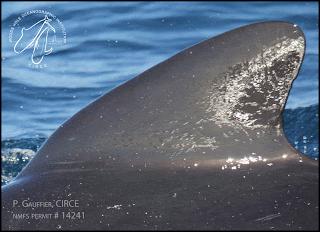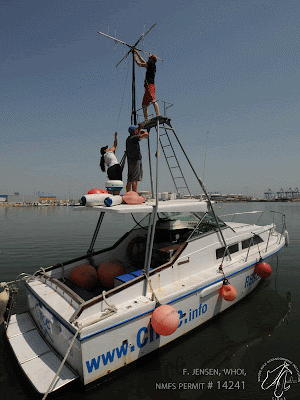How much light do we really need to tag a couple of whales?
Around 4 in the afternoon, we had been enjoying a fresh squeezed orange juice while working in a cafe. Tired after a couple days on the water, we were mentally making a list of all the things we had to do before going out to sea at dawn the next morning. It was the last week of our trip, and as our expedition was drawing to a close, we were looking forward to heading home and analyzing the data we had collected. All of a sudden we received an unexpected call from our captain Philippe, informing us that the wind had just shifted and that we could take an evening trip out into the Strait.
Around 4 in the afternoon, we had been enjoying a fresh squeezed orange juice while working in a cafe. Tired after a couple days on the water, we were mentally making a list of all the things we had to do before going out to sea at dawn the next morning. It was the last week of our trip, and as our expedition was drawing to a close, we were looking forward to heading home and analyzing the data we had collected. All of a sudden we received an unexpected call from our captain Philippe, informing us that the wind had just shifted and that we could take an evening trip out into the Strait.
 |
| A large long-finned pilot whale newly instrumented with its own DTAG |
Weather windows in the strait are few and far between, so we seized this
opportunity. Usually we prepare for a few hours the night before a
deployment and then for another hour or so in the morning, but we didn't
have long before dark, so we raced home and assembled everything as
quickly as possible - tags, tracking equipment, cameras, radios, food,
water, warm clothes and coffee… the list is long, but by this point we
know it by heart.
 |
| An older juvenile surfaces just before being tagged |
We drove to Algeciras where our boat had been
moored during a strong easterly wind and got underway as fast as
possible. Algeciras is a more sheltered moorage than Tarifa, but it
also takes much longer to get to the whales' known habitat. It would be
at least an hour and a half before we could really begin looking for
whales and sunset was fast approaching.
Finally, we arrived in
deep water where the whales were usually found. As the sun dropped
towards the horizon, we were all eyes, trying to spot the faint blow of a
pilot whale in the distance, or the slight reflection of a dorsal fin.
With no luck, we were resigning ourselves to return to Tarifa and head
out at dawn the next morning.
 |
| Night descends on the Strait |
Then, just as the sun set, we were joined by a group of very curious pilot whales,
many of them younger juveniles. Whales in the strait often have to swim
fast to fight the strong currents and maintain their position, but these
animals were bow-riding off Elsa and almost asking to be tagged.
Philippe quickly verified that all the animals were resident individuals
and we identified a female and older juvenile that seemed to be a
distinct sub-group. With the whales in a friendly mood, things went
really fast, and just as darkness descended on the strait, we had two
tags sitting on our chosen animals and the regular beep of their radio
transmitters to take us away into the night.
---
Nicholas Macfarlane and Frants Jensen
---
Nicholas Macfarlane and Frants Jensen























